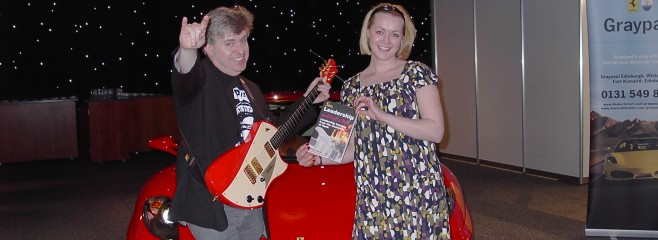 Andy Warhol, The Factory and The Velvet Underground were synonymous with a groundbreaking synaesthesia in music and art in the 1960’s. Their influence has been pervasive over nearly 50 years on people such as The Sex Pistols, The Doctors of Madness, The Cure, The Psychedelic Furs, Patti Smith, Vaclav Havel, Bill Nelson, Iggy Pop, The New York Dolls and many more. Simply stated:
Andy Warhol, The Factory and The Velvet Underground were synonymous with a groundbreaking synaesthesia in music and art in the 1960’s. Their influence has been pervasive over nearly 50 years on people such as The Sex Pistols, The Doctors of Madness, The Cure, The Psychedelic Furs, Patti Smith, Vaclav Havel, Bill Nelson, Iggy Pop, The New York Dolls and many more. Simply stated:
“The first Velvet Underground album only sold 10,000 copies, but everyone who bought it formed a band.”
Today I’m looking at the qualities that led to the success of The Factory as a music innovation incubator, with parallel lessons for businesses wishing to make innovation part of their business as usual activity. See also the post on Lou Reed. My epiphany came about after many years of teaching an MBA programme in creativity and innovation for the Open University Business School. I noticed that the example of The Factory has useful parallels with the four ‘P’s of innovation: Person; Place; Product; Process. To help tell the story of Andy Warhol and The Factory to the uninitiated, I’ve linked these to music from the great retrospective album by Lou Reed and John Cale “Songs for Drella”. Note “Drella” was a nickname for Warhol – a combination of Cinderella and Dracula!
Person – The song “Open House” makes reference to the grating tension between the Velvet Underground’s personalities – e.g. Reed – Cale and Warhol’s role as a creative leader – demonstrating permission giving behaviours and creating a climate where different things could happen. Many creativity experts only emphasise the positive aspects of creative people, yet much creativity comes out of struggle, sometimes with the task, but sometimes through tensions between the people. This also occurs in corporate life:
“Because of the trust and respect we’ve built up, like an old married couplewe are able to rubbish each other’s ideas. Yes we have to kill our babies – it’s the only way to arrive at a viable idea”
Simon Kershaw, Creative Director for the Land Rover Discovery
Check “Open House” out and listen carefully to the words:
Place – For me, the idea of ‘Place’ refers to the physical and psychological environment that encourages innovation. The parallel is in seeing The factory as a business incubator or ‘innovation hothouse’. John Cale said:
“It wasn’t called the Factory for nothing. It was where the assembly line for the silkscreens happened. While one person was making a silkscreen, somebody else would be filming a screen test. Every day something new”
Andy Warhol clearly understood what business schools would call ‘innovation climate’, building a physical and psychological environment where people would be inspired to think great ideas and then convert them to finished product. The principles behind innovation climate are neatly summed up by a rich picture designed by one of my MBA Alumni. Mail me for more background on this highly condensed view of innovation research.
Warhol cared less about traditional boundaries of art and this is what the rich picture calls ‘explore the givens’. This is epitomised in Reed and Cale’s piece “The trouble with the classicists.” Take a listen:
Product – The Factory produced uncompromising real life ‘art’ that dealt with subjects largely untouched by the art world – at the same time Warhol’s protégé’s produced an unending supply of sensational pop art, such as the images of Marilyn Monroe and Campbell’s Soup. Despite the huge diversity, whatever emerged was instantly recognisable as coming from The Factory. In effect, The Factory was an ‘anti-corporate brand’ much in the same way that punk rock and punk clothing quickly became mainstream music and fashion.
Cale and Reed epitomised The Factory’s unending art production line in their words and music to the wonderously grating and dissonant piece “Images”
Process – Andy Warhol was a workaholic, contradicting the view that creativity was about waiting for inspiration to arrive. He favoured perspiration above inspiration and this is poetically summarised in Cale and Reed’s words to their song “Work”:
Finally, we finish with some questions to provoke your own innovation factory:
- Have you got the right people in the right balance to make innovation regular and frequent? Inventors, Innovators and Entrepreneurs?
- Have you got a physical and psychological environment that encourages creativity and calculated risk taking?
- Do you seek constant innovation in the products and services that you provide?
- Have you got reliable strategies and processes for divergent thinking (creativity), convergent thinking (deciding) and converting decisions into innovation (implementation)?
In the spirit of pop art and punk for punk’s sake, my latest micro book “Punk Rock People Management – A no-nonsense guide to hiring, inspiring and firing staff” is available. Our new full size book “The Music of Business” is also available.
We cannot conclude without visiting Lou Reed’s classic “Walk on the Wild Side” which tells stories of many of the personalities at The Factory – Holly Woodlawn, Joe Dallessandro, Candy Darling etc. Coming up soon an interview with the illegitimate Godfather of Punk and confirmed Velvet Underground fanatic Richard Strange.



